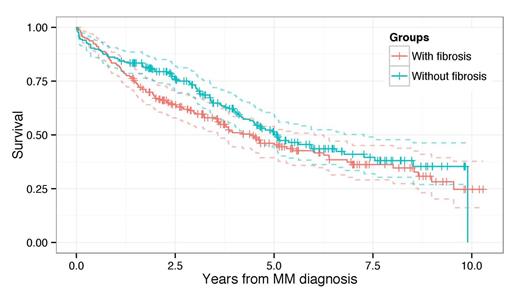Abstract
Multiple myeloma (MM) is characterized by the proliferation of plasma cells in the bone marrow and a secretion of monoclonal immunoglobulins. Survival in MM is very variable and multiple factors are known to influence prognosis such as age, ISS stage, and genetic abnormalities. Fibrosis can be found in the bone marrow of MM patients but the literature reporting the incidence of fibrosis and its effect on prognosis is very limited.
The purpose of this study was to estimate the incidence of bone marrow fibrosis in MM patients and its effect on survival.
Data was collected at the Karolinska University Hospital in Solna, Sweden and information obtained from the hospital's records. We gathered information on all patients diagnosed with MM between 2003 and 2011. All bone marrow reports were reviewed and the presence of bone marrow fibrosis (evaluated using reticulin staining) at diagnosis was recorded. Fibrosis was graded as 1 (mild), 2 (significant) and 3 (advanced), in accordance with WHO 2008 criteria. Patients with fibrosis were paired with patients without fibrosis (matched by sex, birth year, and year of diagnosis). Survival comparing MM patients with and without fibrosis was evaluated using Kaplan-Meier estimate and Cox regression model.
A total of 586 individuals, 327 males and 259 females, were diagnosed with MM at the Karolinska University Hospital, Solna during 2003 – 2011. Evidence of bone marrow fibrosis was noted in 223 (38%) patients at diagnosis, and 175 had fibrosis grade 1, 33 grade 2, and 15 grade 3. No significant difference was observed between males (N = 135) and females (N = 88) (p = 0.085). Mean age at diagnosis was significantly lower for patients with fibrosis (67.1 years) than in patients without fibrosis (69.7 years) (p = 0.013).
Compared with paired patients without fibrosis (N = 217), patients with fibrosis had significantly worse survival (Figure), being 5.0 years vs. 4.4 years, respectively (relative risk (RR)=1.3, 95% confidence interval (CI) 1.00-1.70; p= 0.049). The difference was greatest in male patients and patients younger than 65 years at diagnosis. Survival was worse in patients with advanced fibrosis, 4.5 (95% CI 3.6-6.4) years for grade 1 fibrosis, and 3.0 (95% CI 1.6-NA) years for higher degree of fibrosis.
In this study, based on almost 600 patients with MM we show that bone marrow fibrosis is common at diagnosis (38%). Importantly, our findings show that the presence of fibrosis was associated with inferior survival. More studies are needed regarding the underlying causes for these findings, including treatment response, treatment-related complications and relation to other known prognostic factors.
No relevant conflicts of interest to declare.
Author notes
Asterisk with author names denotes non-ASH members.


This feature is available to Subscribers Only
Sign In or Create an Account Close Modal